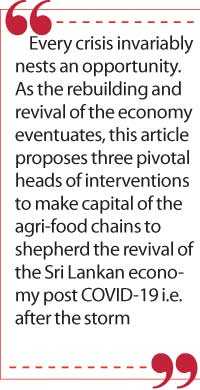Saturday Feb 22, 2025
Saturday Feb 22, 2025
Monday, 27 April 2020 00:39 - - {{hitsCtrl.values.hits}}

The overall impacts on agri-food supply chains in Sri Lanka may not be the slayer that one would expect it to be – Pic by Upul Abayasekara
The impact of the COVID-19 pandemic on the economy of Sri Lanka like anywhere else in the world will be complex to predict in terms of magnitude, but directions are predictable. Being a trade dependent island nation, Sri Lanka will likely suffer from the expected recession in addition to the disruptions in global and domestic supply chains. 
Notwithstanding these effects, our research shows that the overall impacts on agri-food supply chains in Sri Lanka may not be the slayer that one would expect it to be, barring the prolonged disruptions and adverse policy stances in other countries.
Every crisis invariably nests an opportunity. As the rebuilding and revival of the economy eventuates, this article proposes three pivotal heads of interventions to make capital of the agri-food chains to shepherd the revival of the Sri Lankan economy post COVID-19 i.e. after the storm.
1. Target increased export earnings
In 2008 food price crisis, Cambodia was a sole torch bearer of trade openness (not impeding exports of rice) amid the reign of soaring prices. It experienced very significant export earnings. The nature of crisis is different now, but human and policy tendencies would likely remain the same i.e. to look inward. With import substitution likely in vogue it is important to appeal to the powerful idea in trade economics i.e. Lerner Symmetry theorem; an import tax is an export tax.
Taking this crisis as an opportunity, Sri Lanka should be redoubling efforts to increase exports sans COVID. In the height of COVID emergency, the continuance of agri-supply chains including exports engenders hope on agriculture leading from the front in revival. Towards this the following steps can be suggested.
(i) Remove restrictions on raw material and input imports. With raw materials taxed, the effective protection to the domestic producers falls. One of the principal reasons because of which Bangladesh now has the most mechanised agriculture in South Asia is the liberal policies on agriculture machinery. Indeed, Sri Lanka too has policies to giving exemption from Customs duty, import cess and VAT to selected agricultural equipment and machinery. However, the eligibility verification process is cumbersome and highly time consuming limiting the uptake. The recovery drive after COVID-19 offers a great opportunity for improving ease of business that would make availing these concessions easier.
(ii) Conditional on available fiscal space, provide tax concession or compensation with a predetermined tenure and targeting as temporary stimulus to export industries.
(iii) Post COVID-19, international trade is likely to be different with inherent tendencies towards erecting barriers. To confront the new reality, Sri Lanka should proactively and pre-emptively try to strengthen trade links. It should strive for the extensive margin i.e. new products, new markets, new varieties, and prices. History is the proof that all goodly expansion of trade and its resilience have been achieved through extensive margin adjustments, like China, South Korea, or Chile or even in coping with sanctions like in case of Myanmar. In accessing expansion on the extensive margin, new exporters comprising Small and Medium Enterprises (SMEs) will play an important role. Here again, there is a need and opportunity for ease of doing business. The three-tiered registration process involving Export Development Board (EDB), Internal Revenue Department (IRD) and Sri Lanka Customs (SLC) has been onerous and introduces fixed costs disadvantaging SMEs. The ease of doing business that determine time and cost to trade need to be taken up on a priority basis.
2. Rationalise public expenditure in agriculture value chains 
With COVID-19, the thin line between crisis response and structural change often gets blurred. Sri Lanka has gainfully been the exception in South Asia in terms of openness and being less interventionist in food markets. Towards this, intervention during crisis involving procurement and involvement of state agencies could now be soft-pedalled as soon as possible.
In the rebuilding period, all governments would face resource constraints, the pre-existing free distribution of fertilisers might need to be reweighed in favour of the erstwhile cash grant scheme. On the domestic market side, there is a dawn of a rationale for targeting food subsidies. A generalised apportionment through maximum retail prices of rice, dhal and tinned fish is not the most cost-effective way of social protection while Sri Lanka recaptures the high-income growth trajectory after the post 2009 anatomic break.
While targeting, revisions in the list of beneficiaries for Samurdhi program and tapering off distribution of subsidised seeds and planting material for home-gardening projects need consideration. In the nutrition programs there is a recognised need for better targeting to create the fiscal space, this might be the moment to target only the neediest pregnant women.
There should be move to identify the new COVID-19-induced vulnerable (urban poor, recipients of school meal program, people suffering from NCDS, factory workers, communities in remote locations) and make them eligible to receive relief package.
3. Recalibrate domestic food availability and realise gains of innovations in supply chain compression
It is possible that imports might be constrained for some time. As a protective measure, Sri Lanka should use the crisis driven opportunity to mitigate the constraints on domestic availability wherever applicable. There should be a drive to ensure raw materials (seeds, fertilisers, pesticides, packaging materials, etc.) to commence local production and processing.
COVID-19 also offers a great opportunity to foster some long overdue structural changes in agriculture like relaxing restrictions on cultivation of crops other than paddy in lowlands. From the value chain perspective, focal areas would be investment on cold storage facilities and revitalising the extension service. To make the markets competitive, market information system based on government agencies should be widely available.
COVID-19 also brought forth many elements of direct sales to the consumers. As the recovery takes place there is a basis to keep the momentum, incentivise firms which enter on-line marketing tools in food distribution. COVID-19 also brings to the forefront the importance attributes like food safety, biosecurity, and animal health in agricultural value chains. Hence as a path to recovery, Government should provide incentives to connect farmers to markets, engage in value addition and marketing while creating a reward system for healthy agricultural practices.
(Jeevika Weerahewa is attached to the University of Peradeniya, Sri Lanka. Devesh Roy is attached to the International Food Policy Research Institute.)
Discover Kapruka, the leading online shopping platform in Sri Lanka, where you can conveniently send Gifts and Flowers to your loved ones for any event including Valentine ’s Day. Explore a wide range of popular Shopping Categories on Kapruka, including Toys, Groceries, Electronics, Birthday Cakes, Fruits, Chocolates, Flower Bouquets, Clothing, Watches, Lingerie, Gift Sets and Jewellery. Also if you’re interested in selling with Kapruka, Partner Central by Kapruka is the best solution to start with. Moreover, through Kapruka Global Shop, you can also enjoy the convenience of purchasing products from renowned platforms like Amazon and eBay and have them delivered to Sri Lanka.
Discover Kapruka, the leading online shopping platform in Sri Lanka, where you can conveniently send Gifts and Flowers to your loved ones for any event including Valentine ’s Day. Explore a wide range of popular Shopping Categories on Kapruka, including Toys, Groceries, Electronics, Birthday Cakes, Fruits, Chocolates, Flower Bouquets, Clothing, Watches, Lingerie, Gift Sets and Jewellery. Also if you’re interested in selling with Kapruka, Partner Central by Kapruka is the best solution to start with. Moreover, through Kapruka Global Shop, you can also enjoy the convenience of purchasing products from renowned platforms like Amazon and eBay and have them delivered to Sri Lanka.